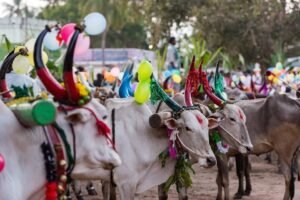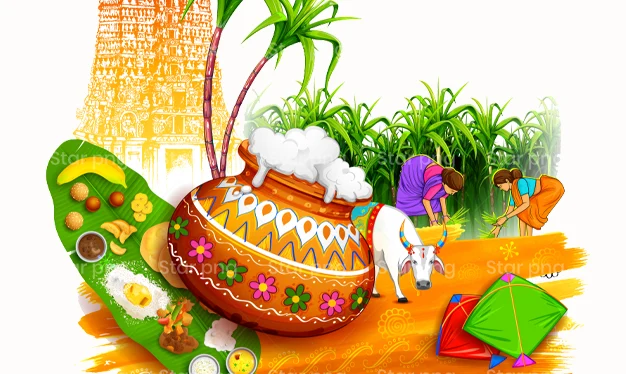Pongal also appertained to as Tai Pongal is amulti-day Hindu crop jubilee celebrated by Tamils in India and Sri Lanka. It’s observed at the launch of the month Tai according to Tamil solar timetable, and this jubilee is famed generally on January 14 or January 15 depending on the sun’s route around earth that particular time. It’s devoted to the sun god, Surya, and corresponds to Makar Sankranti, the crop jubilee under numerous indigenous names celebrated throughout India. The three days of the Pongal jubilee are called Bhogi Pongal, Surya Pongal, and Mattu Pongal. Some Tamils celebrate a fourth day of Pongal known as Kanum Pongal.
According to tradition, the jubilee marks the end of downtime solstice, and the launch of the sun’s six- month-long trip northwards when the sun enters the Capricorn, also called as Uttarayana. The jubilee is named after the conventional” Pongal”, which means” to boil, overflow” and refers to the traditional dish prepared from the new crop of rice boiled in milk with jaggery( raw sugar). To mark the jubilee, the pongal dish is set, first offered to the gods and goddesses, including Surya. Mattu Pongal is for deification of the cow known as Madu. Cattle are bathed, their cornucopias polished and painted in bright colors, and libraries of flowers placed around their necks. The pongal that has been offered to the divinities is also given to cattle, and also participated by the family. gleeful fests include decorating cows and their cornucopias, ritual bathing and processions. It’s traditionally an occasion for decorating rice- greasepaint grounded kolam artworks, offering prayers in the home, tabernacles, getting together with family and musketeers, and swapping gifts to renew social bonds of solidarity.
History
The top theme of Pongal is thanking the Sun god, the forces of nature, and the ranch creatures and people who support husbandry. The Pongal jubilee is mentioned in an necrology in the Viraraghava tabernacle devoted to Vishnu( in Thiruvallur). Credited to the Chola king Kulottunga I( 1070 – 1122 CE), the necrology describes a entitlement of land to the tabernacle for celebrating the periodic Pongal fests. also, the 9th- century Shiva bhakti textbook Tiruvembavai by Manikkavachakar vividly mentions the jubilee. still, there’s no substantiation in the holy Holy Writ for celebrating Pongal.
A scholar of Sanskrit and Tamil traditions, the history of the Pongal dish in gleeful and religious environment can be traced to at least the Chola period. It appears in multitudinous textbooks and eulogies with variant spellings. In early records, it appears as ponakam, tiruponakam, ponkal and analogous terms. Some of the major tabernacle eulogies from Chola Dynasty to Vijayanagara Empire ages include detailed form which are basically the same as the pongal fashions of the ultramodern period, but for the variations in seasonings and relative quantities of the constituents. Further, the terms ponakam, ponkal and its prefixed variants have meant either the gleeful pongal dish by itself as prasadam, or the pongal dish as part of entire thali( now alankara naivedya). These were a part of the charitable subventions entered and served by free community kitchens in Tamil, Karnataka and Andhra Pradesh Hindu tabernacles either as jubilee food or to pilgrims every day.
Signifcance
People celebrating Pongal should be apprehensive of the meaning & significance of the important rituals associated with this crop jubilee. Pongal or Thai Pongal is also called Makara Sankaranthi, since it’s celebrated on the first day of Thai when the Sun enters the Makara Rasi( Capricornus). This signals the end of downtime and the onset of spring throughout the northern semicircle. For the coming six months, the days are longer and warmer. The period is appertained to as Uttarayan Punyakalam and is considered auspicious. Legend has it that the Devas wake up after a six- month long slumber during this period. And so it’s believed that those pass down during Uttarayana attain deliverance. In fact, Bheeshma is believed to have awaited for the dawn of Uttarayana before he gave up his life.
Pongal is a four- day affair. The first day, Bhogi, is celebrated on the last day of the month of Margazhi. On this day, people embellish their homes. New vessels are bought and old and unwanted effects burnt. Scholars have frequently compared Bhogi to the Indra Vizha celebrated by the Chola lords at Kaveripattinam, also known as Poompuhar. Indra Vizha was celebrated in honour of Lord Indra, also called Bhogi, the God of thunder and rain. The alternate day is Perum Pongal, the most important. It’s also called Surya Pongal because people worship Surya, the Sun God and his consorts, Chaya and Samgnya. Women embellish the central yard of their homes with beautiful kolams, done with rice flour and framed with red complexion. The Pongal dish is cooked exactly at the moment when the new month is born. There are several legends associated with Perum Pongal. A savant named Hema supplicated to Lord Vishnu on the banks of the Pottramarai tank in Kumbakonam. On Perum Pongal day, the lord is believed to have taken the form of Sarangapani and blessed the savant. Yet another legend has it that Lord Shiva performed a phenomenon where a gravestone image of an giant ate a piece of sugarcane.
The third day is Mattu Pongal, celebrated to glorify cattle that help growers in a myriad ways. On this day, the cows are bathed and decorated with vermilion and libraries and fed. In certain townlets in southern Tamil Nadu, a bullfight called manji- virattu is held in the evening. Bags of coins are tied to the stropped cornucopias of ferocious bulls that are let loose in an open ground. The youthful men of the vill battle with each other to subdue the bull and snare the bags tied to the cornucopias. In fact, in ancient Tamil literature, men had to subdue the bull in order to win the hand of a fair demoiselle and indeed Lord Krishna is believed to have defeated seven bulls before marrying Nappinnai. Unlike in the Spanish bullfights, in manji- virattu, the bull is noway killed. Mattu Pongal has little significance to megacity folks. In utmost civic homes, the day is celebrated as Kannu Pongal. Special prayers are offered by women for the well- being of their sisters.
The Tamils also flash back the minstrel Tiruvalluvar, who was born on this. The last day is Kaanum Pongal. It’s that part of the jubilee when families used to gather on the strands and have a luxurious mess( kootanchoru). It’s also time for some traditional balls similar as kummi and kolattam. In recent times, that day is celebrated as Uzhavar Tirunal in honor of growers.
Bhogi Pongal

The Pongal jubilee begins on the day called Bhogi Pongal, and it marks the last day of the Tamil month Marghali. On this day people discard old things and celebrate new effects. The people assemble and light a campfire in order to burn the stacks of rejects. Houses are gutted, painted and decorated to give a gleeful look. The cornucopias of oxen and buffaloes are painted in townlets. New clothes are worn to mark the launch of the jubilee. The deity of the day is Indra – the god of rains, to whom prayers are offered, with thanks and expedients for generous rains in the time ahead. Bhogi is also observed on the same day in Karnataka and Andhra Pradesh. In the form called Bhogi Pallu, fruits of the crop similar as regi pallu and sugar club are collected along with flowers of the season. plutocrat is frequently placed into a admixture of treats and is poured over children. The children also separate and collect the plutocrat and sweet fruits.
Tai Pongal

Tai Pongal – also called Suryan Pongal or Perum Pongal – is the alternate and main gleeful day, and is devoted to the sun god It’s the first day of the Tamil timetable month Tai, and coincides with Makara Sankranthi – a downtime crop jubilee celebrated throughout India. The day marks the launch of the Uttarayana, when the sun enters the 10th house of the wheel Makara( Capricorn). The day is celebrated with family and musketeers, with the Pongal dish prepared in a traditional earthen pot in an open space in the view of the sun. The pot is generally decorated by tying a turmeric factory or flower symposium, and near the cuisine cookstove are placed two or further altitudinous fresh sugarcane stalks. The pongal dish is traditionally prepared by boiling milk, in a group setting. When it starts to bubble, lately gathered rice grains and club sugar are added to the pot. As the dish begins to pustule and overflow out of the vessel, one or further actors blow a conch called the sanggu while others roar with joy” Pongalo Pongal”! – lit.” may this rice pustule over”. This is symbolism for the participated want of lesser fortunes in the time ahead. In pastoral settings, the gathered women or neighbors sing” kuruvai rattles”( traditional songs) while the pongal dish is cooking. The dish is offered to the gods and goddesses, occasionally to the vill cows, and also participated by the community. Men traditionally offer prayers to the sun with the” vanakkam” posture in open, and also do to eat their mess. According to James Lochtefeld, the Pongal dish is first offered to Surya and Ganesha, and also participated with the gathered musketeers and family.
Mattu Pongal

Mattu Pongal is celebrated the day after Surya Pongal. Mattu refers to” cow, bullock, cattle”, and Tamil people irrespecive of religion, regard cattle as sources of wealth for furnishing dairy products, toxin, transportation and agrarian aid. On Mattu Pongal, cattle are decorated – occasionally with flower libraries or painted cornucopias, they’re offered bananas, a special mess and worshipped. Some embellish their cows with manjalthanni( turmeric water) and oil painting. Shikakai apply kungumam( kumkum) to their facades , paint their cornucopias, and feed them a admixture of venn pongal, jaggery, honey, banana and other fruits. Others bathe their cattle and prostrate before them with words of thanks for the help with the crop. In metropolises, the day marks the ritual visit to near tabernacles and prayers there. tabernacles and communities hold processions by parading icons from the sanctum of the tabernacle in rustic chariots, drama- cotillion performances encouraging social gatherings and renewal of community bonds. Other events during Pongal include community sports and games similar as cattle race, the Jallikattu. The major artistic carnivals on Pongal do near Madurai.
Kanum Pongal

Kanum Pongal, occasionally called the Kanu Pongal, the fourth day of the jubilee, marks the end of Pongal fests for the time. The word kanum( kaanum) in this environment means” to visit.” numerous families hold reunions on this day. Communities organize social events to strengthen collective bonds. townies cut and consume ranch fresh sugarcane during social gatherings.( 46) Cousins, musketeers and neighbors visit to hail, while youths go out to meet seniors among the cousins and neighborhoods to pay felicitations and seek blessings, while some elders give the visiting children some fund change as a gift. Kanu Pidi is a tradition observed on Mattu Pongal by women and youthful girls. They place a splint of turmeric factory outside their home, and feed the leftover pongal dish and food from Surya Pongal to the catcalls, particularly crow. They supplicate for their sisters’ well being, in a manner analogous to Bhaiya dooj in north India. Sisters pay special homage to their wedded sisters by giving gifts as protestation of their filial love.

